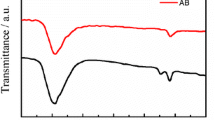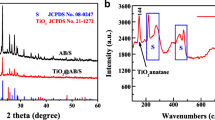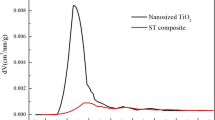Abstract
The lithium–sulfur (Li–S) battery system is one of the most promising candidates for electric vehicle applications due to its higher energy density when compared with conventional lithium ion batteries. Even though, there are so many hindrances, such as insulation nature of sulfur and shuttle mechanism, to prohibit the commercialization of lithium–sulfur batteries. Herein, a facile method to improve the performance of lithium–sulfur (Li–S) batteries was reported. The composites were prepared by simple heat treatment method by embodied with carbon black (CB) and TiO2 to the sulfur. The improvement in capacity can be attributed to subsistence of the TiO2 to augment the electrochemical performance of the Li–S battery. The as-prepared cathode material exhibits the initial discharge capacity of 1399 mAh g−1 at 0.1 C.









Similar content being viewed by others
References
Kang WM, Deng NP, Ju JG, Li QX, Wu DY, Ma XM, Li L, Naebe M, Cheng BW (2016) A review of recent developments in rechargeable lithium–sulfur batteries. Nanoscale 8:16541–16588. https://doi.org/10.1039/C6NR04923K
Deng DP, Kang WM, Liu YB, Ju JG, Wu DY, Li L, Hassan BS, Cheng BW (2016) A review on separators for lithium sulfur battery: Progress and prospects. J Power Sources 331:132–155. https://doi.org/10.1016/j.jpowsour.2016.09.044
Palomares V, Serras P, Villaluenga I, Hueso KB, Carretero-Gonzalez J, Rojo T (2012) Na-ion batteries, recent advances and present challenges to become low cost energy storage systems. Energy Environ Sci 5:5884–5901. https://doi.org/10.1039/C2EE02781J
Ji L, Meduri P, Agubra V, Xiao X, Alcoutlabi M (2016) Graphene-based nanocomposites for energy storage. Adv Energy Mater 6:1502159. https://doi.org/10.1002/aenm.201502159
Agubra VA, Zuniga L, Flores D, Villareal J, Alcoutlabi M (2016) Composite nanofibers as advanced materials for Li-ion, Li-O2 and Li-S batteries. Electrochim Acta 192:529–550. https://doi.org/10.1016/j.electacta.2016.02.012
Muruganantham R, Sivakumar M, Subadevi R, Wu NL (2015) A facile synthesis and characterization of LiFePO4/C using simple binary reactants with oxalic acid by polyol technique and other high temperature methods. J Mater Sci Mater Electron 26:2095–2106. https://doi.org/10.1007/s10854-014-2653-0
Manthiram A, Fu YZ, Su YS (2013) Challenges and prospects of lithium–sulfur batteries. Acc Chem Res 46:1125–1134. https://doi.org/10.1021/ar300179v
Manthiram A, Fu Y, Chung SH, Zu C, Su YS (2014) Rechargeable lithium–sulfur batteries. Chem Rev 114:11751–11787. https://doi.org/10.1021/cr500062v
Papandrea B, Xu X, Xu Y, Chen CY, Lin Z, Wang G, Luo Y, Liu M, Huang Y, Mai L, Duan X (2016) Three-dimensional graphene framework with ultra-high sulfur content for a robust lithium–sulfur battery. Nano Res 9:240–248. https://doi.org/10.1007/s12274-016-1005-1
Tao X, Wang J, Liu C, Wang H, Yao H, Zheng G, She ZW, Cai Q, Li W, Zhou G, Zu C, Cui Y (2016) Balancing surface adsorption and diffusion of lithium-polysulfides on nonconductive oxides for lithium–sulfur battery design. Nat Commun 7:11203. https://doi.org/10.1038/ncomms11203
Li GX, Sun JH, Hou WP, Jiang SD, Huang Y, Geng JX (2016) Three-dimensional porous carbon composites containing high sulfur nanoparticle content for high-performance lithium–sulfur batteries. Nat Commun 7:10601. https://doi.org/10.1038/ncomms10601
Jiang J, Zhu J, Ai W, Wang X, Wang Y, Zou C, Huang W, Yu T (2015) Encapsulation of sulfur with thin-layered nickel-based hydroxides for long-cyclic lithium–sulfur cells. Nat.Commun. 6:8622. https://doi.org/10.1038/ncomms9622
Chen S, Sun B, Xie X, Mondal AK, Huang X, Wang G (2015) Multi-chambered micro/mesoporous carbon nanocubes as new polysulfides reserviors for lithium–sulfur batteries with long cycle life. Nano Energy 16:268–280. https://doi.org/10.1016/j.nanoen.2015.05.034
Cao R, Chen J, Han KS, Xu W, Mei D, Bhattacharya P, Engelhard MH, Mueller KT, Liu J, Zhang JG (2016) Effect of the anion activity on the stability of Li metal anodes in lithium-sulfur batteries. Adv Funct Mater 26:3059–3066. https://doi.org/10.1002/adfm.201505074
Gao M, Xiong X, Wang W, Zhao S, Li C, Zhang H, Yu Z, Huang Y (2014) Discharge–charge process of the porous sulfur/carbon nanocomposite cathode for rechargeable lithium sulfur batteries. J Power Sources 248:1149–1155. https://doi.org/10.1016/j.jpowsour.2013.10.007
Jayaprakash N, Shen J, Moganty SS, Corona A, Archer LA (2011) Porous hollow carbon@sulfur composites for high-power lithium-sulfur batteries. Angew Chem Int Ed 50:5904–5908. https://doi.org/10.1002/anie.201100637
Zu C, Manthiram A (2013) Hydroxylated graphene–sulfur nanocomposites for high-rate lithium–sulfur batteries. Adv Energy Mater 3:1008–1012. https://doi.org/10.1002/aenm.201201080
Guo J, Xu Y, Wang C (2011) Sulfur-impregnated disordered carbon nanotubes cathode for lithium–sulfur batteries. Nano Lett 11:4288–4294. https://doi.org/10.1021/nl202297p
Yao S, Tang H, Liu M, Chen L, Jing M, Shen X, Li T, Tan J (2019) TiO2 nanoparticles incorporation in carbon nanofiber as a multi-functional interlayer toward ultralong cycle-life lithium-sulfur batteries. J Alloys Compd 788:639–648. https://doi.org/10.1016/j.jallcom.2019.02.236
Yao S, Zhang C, Xie F, Xue S, Gao K, Guo R, Shen X, Li T, Qin S (2020) Hybrid membrane with SnS2 nanoplates decorated nitrogen-doped carbon nanofibers as binder-free electrodes with ultrahigh sulfur loading for lithium sulfur batteries. ACS Sustain Chem Eng 8(7):2707–2715. https://doi.org/10.1021/acssuschemeng.9b06064
Wang X, Le W, Hu R, Xia P, Pan Y, Ma Z, Zhao N, Wang Y (2020) TiO2-coated sulfur-carbon nanocomposite cathode for lithium-sulfur batteries. Ionics. https://doi.org/10.1007/s11581-020-03619-0
Yao S, Zhang C, He Y, Li Y, Wang Y, Liang Y, Shen X, Li T, Qin S, Xiang J (2020) Functionalization of nitrogen doped carbon nanofibers with polyamidoamine dendrimer as freestanding electrode with high sulfur loading for lithium-polysulfides batteries. ACS Sustain Chem Eng 8(21):7815–7824. https://doi.org/10.1021/acssuschemeng.0c00300
Jin G, Mingang Z, Shijian Y, Xiaoyan Y, Shiwei W (2018) Electrochemical properties of modified acetylene black/sulfur composite cathode material for lithium/sulfur batteries. Ionics 24(8):2219–2225. https://doi.org/10.1007/s11581-017-2351-z
Yao S, Xue S, Peng S, Jing M, Shen X, Li T, YiLiu Z (2019) Electrospun zeolitic imidazolate framework-derived nitrogen-doped carbon nanofibers with high performance for lithium-sulfur batteries. Int J Energy Res 43(5):1892–1902. https://doi.org/10.1002/er.4389
Dong K, Wang S, Zhang H, Wu JP (2013) Preparation and electrochemical performance of sulfur-alumina cathode material for lithium-sulfur batteries. Mater Res Bull 48:2079–2083. https://doi.org/10.1016/j.materresbull.2013.02.031
Zhang YG, Bakenov Z, Zhao Y, Konarov A, Doan T, Sun K, Yermukhambetova A, Chen P (2013) Effect of nanosized Mg0.6Ni0.4O prepared by self-propagating high temperature synthesis on sulfur cathode performance in Li/S batteries. Powder Technol 235:248–255. https://doi.org/10.1016/j.powtec.2012.10.023
Zhang YG, Zhao Y, Yermukhambetova A, Bakenov Z, Chen P (2013) Ternary sulfur/polyacrylonitrile/Mg0.6Ni0.4O composite cathodes for high performance lithium/sulfur batteries. J Mater Chem 1:A295–A301. https://doi.org/10.1039/C2TA00105E
Zheng W, Hu XG, Zhang CF (2006) Electrochemical properties of rechargeable lithium batteries with sulfur-containing composite cathode materials. Electrochem Solid-State Lett 9:A364–A367. https://doi.org/10.1149/1.2203348
Evers S, Yim T, Nazar LF (2012) Understanding the nature of absorption/adsorption in nanoporous polysulfide sorbents for the Li–S battery. J Phys Chem C 116:19653–19658. https://doi.org/10.1021/jp304380j
Li J, Ding B, Xu G, Hou L, Zhang X, Yuan C (2013) Enhanced cycling performance and electrochemical reversibility of a novel sulfur-impregnated mesoporous hollow TiO2 sphere cathode for advanced Li–S batteries. Nanoscale 5:5743–5746. https://doi.org/10.1039/C3NR01393F
Ding B, Shen L, Xu G, Nie P, Zhang X (2013) Encapsulating sulfur into mesoporous TiO2 host as high performance cathode for lithium–sulfur battery. Electrochim Acta 107:78–84. https://doi.org/10.1016/j.electacta.2013.06.009
Vinayan BP, Zhirong ZK, Diemant T, Chakravadhanula VSK, Schwarzburger NI, Cambaz MA, Behm RJ, Kübel C, Fichtner M (2016) Performance study of magnesium–sulfur battery using a graphene based sulfur composite cathode electrode and a non-nucleophilic Mg electrolyte. Nanoscale 8:3296–3306. https://doi.org/10.1039/C5NR04383B
Zheng P, Liu T, Su Y, Zhang L, Guo S (2016) TiO2 nanotubes wrapped with reduced graphene oxide as a high-performance anode material for lithium-ion batteries. Sci Rep 6:36580. https://doi.org/10.1038/srep36580
Wang B, Xin H, Li X, Cheng J, Yang G, Nie F (2014) Mesoporous CNT@TiO2-C nanocable with extremely durable high rate capability for lithium-ion battery anodes. Sci Rep 4:3729. https://doi.org/10.1038/srep03729
Ma XZ, Jin B, Wang HY, Hou JZ, Zhong XB, Wang HH, Xin PM (2015) S–TiO2 composite cathode materials for lithium/sulfur batteries. J Electroanal Chem 736:127–131. https://doi.org/10.1016/j.jelechem.2014.11.007
Li Q, Zhang Z, Zhang K, Xu L, Fang J, Lai Y, Li JL (2013) Synthesis and electrochemical performance of TiO2–sulfur composite cathode materials for lithium–sulfur batteries. J Solid State Electrochem 17:2959–2965. https://doi.org/10.1007/s10008-013-2203-3
Chmiola J, Yushin G, Gogotsi Y, Portet C, Simon P, Taberna PL (2006) Anomalous increase in carbon capacitance at pore sizes less than 1 nanometer. Science 313:1760–1176. https://doi.org/10.1126/science.1132195
He X, Hou H, Yuan X, Huang L, Hu J, Liu B, Xu J, Xie J, Yang J, Liang S, Wu X (2017) Electrocatalytic activity of lithium polysulfides adsorbed into porous TiO2 coated MWCNTs hybrid structure for lithium-sulfur batteries. Sci Rep 7:40679. https://doi.org/10.1038/srep40679
Kong L, Handa Y, Taniguchi I (2016) Synthesis and characterization of sulfur–carbon–vanadium pentoxide composites for improved electrochemical properties of lithium–sulfur batteries. Mater Res Bull 73:164–170. https://doi.org/10.1016/j.materresbull.2015.08.036
Rajkumar P, Diwakar K, Radhika G, Krishnaveni K, Subadevi R, Sivakumar M (2019) Effect of silicon dioxide in sulfur/carbon black composite as a cathode material for lithium sulfur batteries. Vacuum 161:37–48. https://doi.org/10.1016/j.vacuum.2018.12.016
Liu J, Wang C, Liu B, Ke X, Liu L, Shi Z, Zhang H, Guo Z (2017) Rational synthesis of MnO2@ CMK/S composite as cathode materials for lithium–sulfur batteries. Mater Lett 195:236–239
Zhang SS (2012) Effect of discharge cutoff voltage on reversibility of lithium/sulfur batteries with LiNO3-contained electrolyte. J Electrochem Soc 159(7):A920–A923
Palanisamy R, Karuppiah D, Rengapillai S, Ramasamy G, Abdollahifar M, Wang FM, Marimuthu S (2020) Enhanced electrochemical performance of MWCNT-intercalated silica/sulfur composite cathode for rechargeable lithium-sulfur batteries. JOM 72:2260–2268
Peng H, Zhang Z, Huang J, Zhang G, Xie J, Xu W, Shi J, Chen X, Cheng X, Zhang Q (2016) A cooperative interface for highly efficient lithium–sulfur batteries. Adv Mater 28:9551–9558. https://doi.org/10.1002/adma.201603401
Zu C, Fu Y, Manthiram A (2013) Highly reversible Li/dissolved polysulfide batteries with binder-free carbon nanofiber electrodes. J Mater Chem A 1:10362. https://doi.org/10.1039/C3TA11958K
Zhou G, Li L, Ma C, Wang S, Shi Y, Koratkar N, Ren W, Li F, Cheng HM (2015) A graphene foam electrode with high sulfur loading for flexible and high energy Li-S batteries. Nano Energy 11:356–365. https://doi.org/10.1016/j.nanoen.2014.11.025
Zhang J, Xiang J, Dong Z, Liu Y, Wu Y, Xu C, Du G (2014) Biomass derived activated carbon with 3D connected architecture for rechargeable lithium-sulfur batteries. Electrochim Acta 116:146–151. https://doi.org/10.1016/j.electacta.2013.11.035
Acknowledgements
All the authors from Alagappa University received financial support from DST-SERB, New Delhi, under the Physical Sciences grant received vide EMR/2016/006302. All the authors gratefully acknowledge for extending the analytical facilities in the Department of Physics, Alagappa University, under the PURSE and FIST programs, sponsored by Department of Science and Technology (DST), SAP by University Grants Commission (UGC), New Delhi, Government of India, and Ministry of Human Resource Development RUSA-Phase 2.0 grant sanctioned vide Lt.No.F-24-51/2014 U Policy (TNMulti Gen), Department of Education, Government of India.
Funding
All the authors from Alagappa University received financial support from DST-SERB, New Delhi, under the Physical Sciences, grant sanctioned vide EMR/2016/006302.
Author information
Authors and Affiliations
Corresponding author
Additional information
Publisher’s note
Springer Nature remains neutral with regard to jurisdictional claims in published maps and institutional affiliations.
Electronic supplementary material
ESM 1
(DOCX 247 kb).
Rights and permissions
About this article
Cite this article
Radhika, G., Rajkumar, P., Subadevi, R. et al. Effect of TiO2/carbon black in sulfur-based composite cathode for lithium–sulfur batteries. Ionics 26, 5463–5470 (2020). https://doi.org/10.1007/s11581-020-03691-6
Received:
Revised:
Accepted:
Published:
Issue Date:
DOI: https://doi.org/10.1007/s11581-020-03691-6




